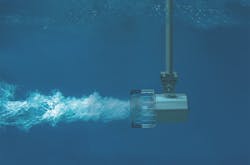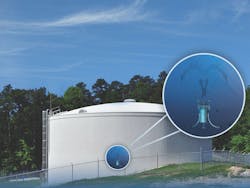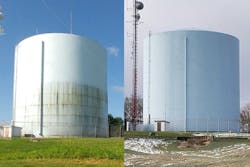About the author:
Lucy Allen is the municipal business development manager for Kasco Marine. She has more than 15 years of experience in the water and wastewater industry and is an expert on water tank mixing.
Municipal water tanks and reservoirs are valuable assets for healthy, thriving communities. They represent a sizable capital investment and are a critical component to the quality of potable water supply. Ensuring clean drinking water is important to the overall health and safety of every community.
Add a Mixer
In order to maintain safe water, water in a tank must be moving. Static water conditions in a water tank can cause issues in all seasons. In winter, static water freezes, damaging the tank and its coating. In summer, temperature and chemical stratification can impact both the tank and water quality. These issues can lead to increased water age and reduced chlorine residuals, which can cause an increased risk of nitrification and increased production of disinfection by-products.
A mixing system is an operator’s best tool to help maintain water quality. By adding a mixing system to a water tank, one can ensure the water tank’s integrity by reducing interior headspace temperature and reducing steel corrosion, as well as overall water quality.
Choose A Mixing System
There are many tank mixing systems, but the two most common are active and passive. Determining the appropriate mixing system for a water tank is the first step, and an active tank mixing system should be a primary consideration.
Active mixing systems keep water circulating inside the tank continuously for 24 hours a day and 365 days of the year, regardless of water volume in the tank. They are smaller and more sustainable than passive mixers, as they provide operators with more mixing power, independent of drain and fill cycles. They also are less expensive, easier, and faster to install and can be easily removed for tank inspections and ongoing maintenance.
Seasonally, active tank mixers deter some of the most critical water tank issues, including ice formation and stratification. Through continuous mixing, ice is unable to form, and stratification can never develop. This significantly reduces physical damage from ice formation and minimizes the potential for bio-film growth and disinfection by-products. The result is homogeneous water quality throughout the tank, reducing water age and increasing water quality.
Select Your Mixing System Size and Placement
Tanks and reservoirs come in many styles, shapes, and sizes. It is critical to ensure the proper tank mixing system is in place to meet the unique needs of a utility's municipal water tank, while keeping ease of installation and serviceability in mind.
Active mixing system selection should offer various mounting options to meet the unique tank or reservoir application. Regardless of the size and placement, active mixing systems should be easy to install in new or existing tanks, without using cranes or draining the tanks. Additionally, they should be easily removable for tank inspection and maintenance.
When determining the size and placement of an active tank mixer, carefully review the warranty and the NSF rating. Both are critical components in ensuring a mixing system provides years of service and the electrical and material quality to maintain the system integrity.
Test & Monitor the Mixing System’s Effectiveness
Once an active tank mixing system has been installed and is continuously mixing the water supply, it is a best practice to ensure the tank is mixing effectively, because consistency equals quality.
One method of ensuring effectiveness of active mixing system is to look at the blend cycle. The blend cycle is the time it takes to mix the water to a homogeneous temperature during a fill cycle. For instance, during daily operations, if it takes two hours to refill the tank, then the active mixer needs to be able to re-blend the new water with that already in the tank in two hours.
One can also visibly see whether a tank is actively being mixed by looking at the exterior of it. In the summer months, peer at the water tank. Is there a sweat line? Is there mold growing on the tank in that area? If so, it is indicating that the water below is colder than the water above the thermocline (sweat line). Other ways to test whether your tank is being mixed is to use a temperature data string inside the tank, or an aerial drone that can capture thermal imagery to determine if there is thermal stratification.
Inspect Your Water Mixer for Proactive Maintenance
While active tank mixing is critical for water quality, regular inspection and maintenance of your water tanks and mixing system is critical. Inspections help assess safety and security issues, structural and coating conditions, obvious sanitary concerns and notifies operator of any needed mixer service.
The American Water Works Association has determined a standard schedule of inspection. Visual inspection of your tanks should happen regularly, at a minimum on a monthly basis. Your tanks should be drained, washed and professional inspected at least every three years, if not more often. Your mixing system and ground fault breakers should be checked to make sure they are within manufacture recommendations.
Even with frequent inspections and regular maintenance, problems can still arise. An active tank mixing system is your municipality’s best and most cost-effective solution to prevent these issues and ensure consistent, high quality potable water for the communities you serve.
For more information on active mixing systems and to solve specific problems in your water tanks, learn more about Kasco’s CertiSafe Tank Mixer.
About the Author
Lucy Allen
municipal business development manager
Lucy Allen is the municipal business development manager for Kasco Marine. She has more than 15 years of experience in the water and wastewater industry and is an expert on water tank mixing.


